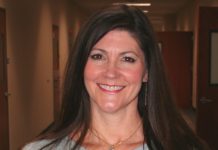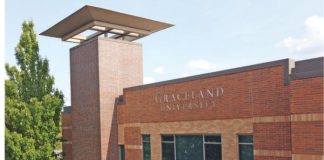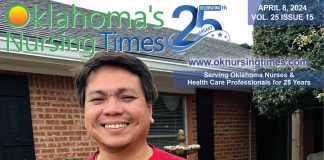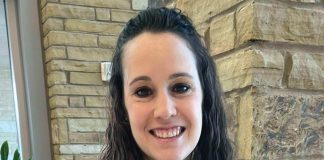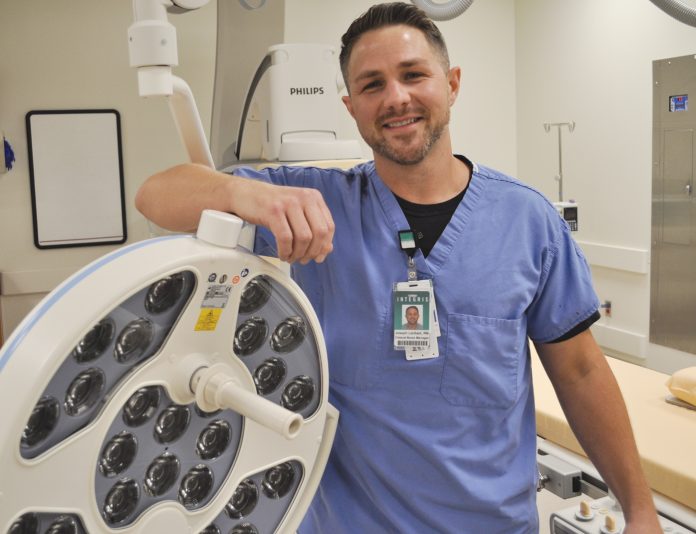
by Bobby Anderson,
Staff Writer
Big things are on the horizon for Western Oklahoma when it comes to cardiovascular care.
And Joseph Lenhart, RN, BSN is right in the thick of it all.
Lenhart joined Integris in April and was onboarded with Integris Canadian Valley Hospital to start up the hospital’s cath lab service offerings.
“Hopefully by the end of summer we can start taking the STEMIs and acute MI’s from EMSA from hopefully Western Oklahoma,” Lenhart said.
It’s a major endeavor for the hospital and one that is taking massive amounts of Lenhart’s time.
“The focus for me is just even though we’re a startup that we’re delivering a really high standard of care,” he said. “We’re trying to get everyone’s experience and allowing everybody to transfer it here. We want to identify what everyone is bringing to the table. We have a lot of people from other cath labs with experience.”
Lenhart admits cath lab workers are a special breed. And Integris Canadian Valley has been drawing them from all over.
“Just how much of your life you’re on call and the fact that you spend a lot of your after-hours life with work people after emergencies,” Lenhart said of the reason why cath lab personnel get close. “There’s quite a bit of buy-in. People are pretty invested in the whole process which is kind of neat when you set stuff up because everybody kind of knows what they’ve seen and what works best from different areas.”
That’s been one of the best parts for Lenhart, who is working on meshing staff together and finding out what worked for them in their previous settings.
And having the Integris backing has made it all the easier.
“For them they’ve been working on it for years as far as the planning with the equipment and kind of evaluating the market,” he said. “There’s been a lot of different ends you have to put together from equipment to coordinating staff and coordinating doctors and then also kind of getting the community’s participation as far as what’s going to be taking place.”
Cath lab patients can trend to very high acuity. Even simple procedures can become quite complex quickly. Everything must be in place to handle whatever comes up.
Lenhart graduated from nursing school in 2004 and spent his first year in pediatric intensive care in Tulsa before digging into his cath lab training.
He’s been there ever since.
“It’s a gratifying area to work in especially with the STEMI’s and MI’s you see immediate results,” he said. “You can have somebody who’s on death’s door and hopefully by the end of the case pain is relieved and ST’s are going down. They’re feeling better from this crushing pain that’s worse than anything they’ve ever had before.
“That’s cool to be able to impact someone at that time.”
Beyond the lab a lot of patients deal with coronary artery disease or peripheral artery disease.
It’s one patient at a time, something Lenhart really gets behind.
Growing up in Tulsa, nursing entered the pictured for Lenhart when he was diagnosed as a Type I diabetic at 18. He spent a lot of time in the hospital that year.
“After that I guess I just saw the impact those people that I dealt with had on my life,” he said.
The Tulsa boy is now in Yukon. It’s been a bit of a change but he’s had his cath lab family to help him along.
“It’s the same processes,” he said with a laugh. “Oklahoma City is definitely a bigger market because of how wide the metro is. You’ve got Norman, Midwest City and so many other hospitals in this market compared to Tulsa which I felt was a little smaller.”
Lenhart is trying to prep the staff for what is about to come. Once the ICVH lab opens up so should a flood of patients from the entire western side of the state.
“I would hope that by being here we would get people before they get a little sicker,” he said. “As far as (something happening) in the field we could shave 30 minutes what they would have to do if they had to keep going east,” he said. “The goal would be to serve the community and get care to them faster. I think it’s better for people if you have to have a stress test or a cath I feel the closer to home you are with that stuff it’s just easier.
“It’s more comfortable and feels safer for people to be closer to the hospital it’s performed.”




